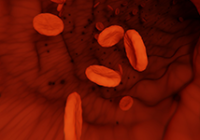By Guy Odishaw, CTO, NFP, Bioelectric Medicine Practitioner
Despite being discovered back in 1847 by Karl Ludwig, heart rate variability, or HRV for short, has been making headlines in recent years with the advent of portable technology coupled with research indicating our heart rate is intimately connected to certain health outcomes.
To unpack the relationship between HRV and health, we first need to understand the symbiosis between the heart, the gut, and the brain. While they are completely different systems, the process of breathing, heart pumping, and digestion are all controlled by one part of the brain: the medulla oblongata.
In scientific terms, that connection is called heart rate variability: a shift in periods between heartbeats as a consequence of breathing. When the heart’s lower chamber fills with blood, it contracts to push blood up to the upper chambers, the systolic phase. When the ventricle relaxes after the contraction, this is called the diastolic phase. Put the two together and you have a single heartbeat. Each beat is mediated by the heart’s natural pacemaker, the sinoatrial (SA) node.
HRV is the variation of time between your heartbeats while heart rate is the number of times your heart beats per minute. If your heart beats 70 times per minute not all beats will have consistent intervals between them. This inconsistency produces a variation in timing from one beat to the next.
The higher the variation–especially at rest–the more tolerant the body’s recovery from stress.
At the center of it all is the brain’s medulla oblongata, part of the autonomic nervous system (ANS). The ANS controls involuntary functions and is of two types: parasympathetic (rest and digest) and sympathetic (fight, flight, freeze). In stressful situations, the sympathetic nervous system activates and increases your heart rate and blood circulation for you to survive. In contrast, the parasympathetic system relaxes your body and activates after resolving the threat.
The ANS controls your HRV because your brain processes information and increases the heart rate by increasing sympathetic flow to the sinoatrial (pacemaker) node of the heart.
What does HRV indicate?
Heart rate variability is reported to indicate mental health issues like anxiety or depression and digestive problems. Those with high HRV appear to be less stressed when responding to sudden changes. In contrast, patients with anxiety, for example, have lower HRV because of abnormally elevated levels of the sympathetic system.
Here’s a rule of thumb:
- Sympathetic activity = low HRV with high heart and respiratory rates
- Parasympathetic activity = high HRV with low heart and respiratory rates
Since the parasympathetic system is responsible for resting and digesting, HRV can significantly impact your digestive issues. It is the parasympathetic system that stimulates saliva production and helps improve the digestive tract’s movement. A low HRV is a tell-tale sign of digestive diseases like irritable bowel syndrome among others.
HRV Biofeedback
Since many chronic issues are indicated by poor heart rate variability, HRV biofeedback has gained traction as a possible treatment option for some conditions. HRV biofeedback training involves repeating a specific breathing pattern that slows down the heart rate, shuts down the sympathetic system, and allows the breathing pattern to resonate with the heart rate patterns.
A trained biofeedback provider begins with finding out the resonance frequency/pace of the patient (the frequency at which their heart rate and breathing synchronize). These patterns are then plotted as an electrocardiogram (ECG) graph on a biofeedback device, where the patient can witness their interactions on a monitor in real time.
To find the frequency, the patient is asked to breathe at a speed of five full breaths per minute. This information is recorded and then prescribed, and their unique pace of HRV training will stay the same throughout the person’s life. They then spend time deliberately breathing at this pace (i.e., “training”) during the course of each day (experts recommend at least 10 minutes of HRV training per day to improve health).
HRV training is a great example of practicing mindfulness as well. Studies have shown that practicing mindfulness for five minutes a day for ten days reduces stress and improves HRV. Deliberate HRV training is also very useful among athletes for measuring and managing their fatigue and stress and building their exercise intensity.
HRV portability, friend or foe?
Popular due to their quick results and portability, the accuracy of wearable devices such as Oura Ring, Polar, and Whoop is still under debate. The FDA has approved some wearable devices for HRV but even approved ones have some challenges associated with accuracy and efficiency.
To note, each brand on the market has its preferred method and time slot for measuring HRV. Most measure the R-R interval (the time between two R waves of the QRS complex system of the heart) during the night or first thing in the morning.
The chest strap (Polar H10 Strap, Garmin HRM Pro) is a popular wearable monitoring device that uses ECG electrodes for HRV monitoring. Its portability allows you to measure HRV at home even while paired with other wearables. However, with a strap, you can only track your HRV during periods of exercise and not throughout the entire day.
Several smartwatch manufacturers (Apple Watch, Garmin Watch, FitBit) have built-in optical sensors for detecting HRV during your daily activities and can be helpful for baseline information. But collecting very few samples at night, or not completing the entire duration for data collection can yield “noisy” data which is why most smartwatches fail to provide accurate information over time.
Going deeper into the details of HRV monitoring, all devices use either ECG (electrocardiography) or PPG (photoplethysmography) to measure HRV. The gold standard for measuring HRV is the ECG which collects the changes in electrical voltage signals produced by the heart from different areas of the skin and wraps them into a graph. These changes are measured via the electrodes worn on the skin with gel.
Meanwhile, PPG uses light sensors (either LED or infrared) for detecting blood volume changes. The source shines a light on the skin, which is reflected back to the photodiode to be converted to an electric current. The amount of light reflected is directly proportional to the changes in pulse pressure.
Which is better, PPG or ECG? It depends on the application:
- PPG is an indirect approach for measuring HRV, while ECG is more direct and accurate and measures at the millisecond level.
- Since most wearables use PPG, it has been shown that PPG is less accurate during physical activities than at rest. Hence, the wearer should be asleep for overnight data collection, which limits its use for daily activities.
- PPG technologies are more portable and flexible than ECG, which requires the electrodes to be close enough to the heart for accuracy.
- Since PPG technology requires a prolonged time for settling, it has been shown to be missing out on relevant data. For instance, a study revealed how a smartwatch failed to collect around 10% of beats during the stressed and relaxed stages.
HRV is an important, non-invasive method for detecting physiological changes in the body during the physical and resting stages. There are multiple ways to detect it, but ECG monitors and machines are found to be more beneficial than the wearables and devices, which use PPG. For proper HRV training, you need accurate data, for which only a few wearables can be relied on, and more studies are needed to detect PPG accuracy.
Please join us on June 6th, 2023 at 12:00 p.m. ET for a deep dive into the ups and downs of heart rate variability on The Marion Institute’s monthly BioBites with Guy Odishaw, CTO, NFP, Healthcare Entrepreneur, Bioelectric Medicine Practitioner. Guy is the founder of Bhakti Wellness Center in Edina, MN, one of the largest and most diverse integrative medicine clinics in the country and co-founder of the first integrative student health clinics in the country at the University of Minnesota.












This Post Has One Comment